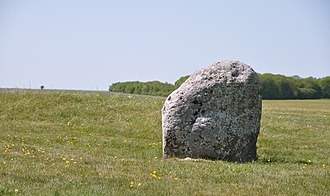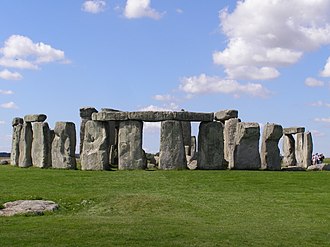4hp-6qm-snq
Amesbury (United Kingdom)
Specifications
| hex ID | 4hp-6qm-snq |
|---|---|
| H3 cell | 8a1959cf4427fff |
| geo center | 51.17915, -1.82588 |
| timezone | Europe/London |
Wikipedia: Q and R Holes
The Q and R Holes are a series of concentric sockets which currently represent the earliest known evidence for a stone structure on the site of Stonehenge.

Wikipedia: Stonehenge, Avebury and Associated Sites
Stonehenge, Avebury and Associated Sites is a UNESCO World Heritage Site (WHS) in Wiltshire, England. The WHS covers two large areas of land separated by about 24 kilometres (15 mi), rather than a specific monument or building. The sites were inscribed as co-listings in 1986. Some large and well known monuments within the WHS are listed below, but the area also has an exceptionally high density of small-scale archaeological sites, particularly from the prehistoric period. More than 700 individual archaeological features have been identified. There are 160 separate scheduled monuments, covering 415 items or features.
Wikipedia: Station Stones
The Station Stones are elements of the prehistoric monument of Stonehenge.

Wikipedia: Excavations at Stonehenge
Records of archaeological excavations at the Stonehenge site date back to the early 17th century.
Wikipedia: Stonehenge
Stonehenge is a prehistoric megalithic structure on Salisbury Plain in Wiltshire, England, two miles (3 km) west of Amesbury. It consists of an outer ring of vertical sarsen standing stones, each around 13 feet (4.0 m) high, seven feet (2.1 m) wide, and weighing around 25 tons, topped by connecting horizontal lintel stones, held in place with mortise and tenon joints, a feature unique among contemporary monuments. Inside is a ring of smaller bluestones. Inside these are free-standing trilithons, two bulkier vertical sarsens joined by one lintel. The whole monument, now in ruins, is aligned towards the sunrise on the summer solstice and sunset on the winter solstice. The stones are set within earthworks in the middle of the densest complex of Neolithic and Bronze Age monuments in England, including several hundred tumuli.

Wikipedia: Heel Stone
The Heel Stone is a single large block of sarsen stone standing within the Avenue outside the entrance of the Stonehenge earthwork in Wiltshire, England. In section it is sub-rectangular, with a minimum thickness of 2.4 metres, rising to a tapered top about 4.7 metres (15 ft) high. Excavation has shown that a further 1.2 metres is buried in the ground.
It is 77.4 metres (254 ft) from the centre of Stonehenge circle. It leans towards the southwest nearly 27 degrees from the vertical. The stone has an overall girth of 7.6 metres (25 ft) and weighs about 35 tons. It is surrounded by the Heelstone Ditch.

Wikipedia: Stonehenge Avenue
Stonehenge Avenue is an ancient avenue on Salisbury Plain, Wiltshire, England. It is part of the Stonehenge, Avebury and Associated Sites UNESCO World Heritage Site. Discovered in the 18th century, it measures nearly 3 kilometres, and connects Stonehenge with the River Avon. It was built during the Stonehenge 3 period of 2600 to 1700 BCE.

Wikipedia: Stonehenge Free Festival
The Stonehenge Free Festival was a British free festival from 1974 to 1984 held at the prehistoric monument Stonehenge in England during the month of June, and culminating with the summer solstice on or near 21 June. It emerged as the major free festival in the calendar after the violent suppression of the Windsor Free Festival in August 1974, with Wally Hope providing the impetus for its founding. By the 1980s, the festival had grown to be a major event, attracting up to 30,000 people in 1984. The festival attendees were branded as hippies by the British press. This, along with the open drug use and sale, contributed to the increase in restrictions on access to Stonehenge, and fences were erected around the stones in 1977. The same year, police resurrected a moribund law against driving over grassland in order to levy fines against festival goers in motorised transport. The festival came to an end in 1985 following the infamous Battle of the Beanfield. What followed was several years of exclusion until the year 2000 when full access was restored.

Wikipedia: Aubrey holes
The Aubrey holes are a ring of 56 chalk pits at Stonehenge, named after seventeenth-century antiquarian John Aubrey. They date to the earliest phases of Stonehenge in the late fourth and early third millennium BC. Despite decades of argument and analysis, their purpose is still unknown, although an astronomical role has often been suggested.

Wikipedia: Altar Stone (Stonehenge)
The Altar Stone is a recumbent central megalith at Stonehenge in England, dating to Stonehenge phase 3i, around 2600 BCE. It is identified as Stone 80 in scholarly articles.

Collections
No one has collected this hex, yet.